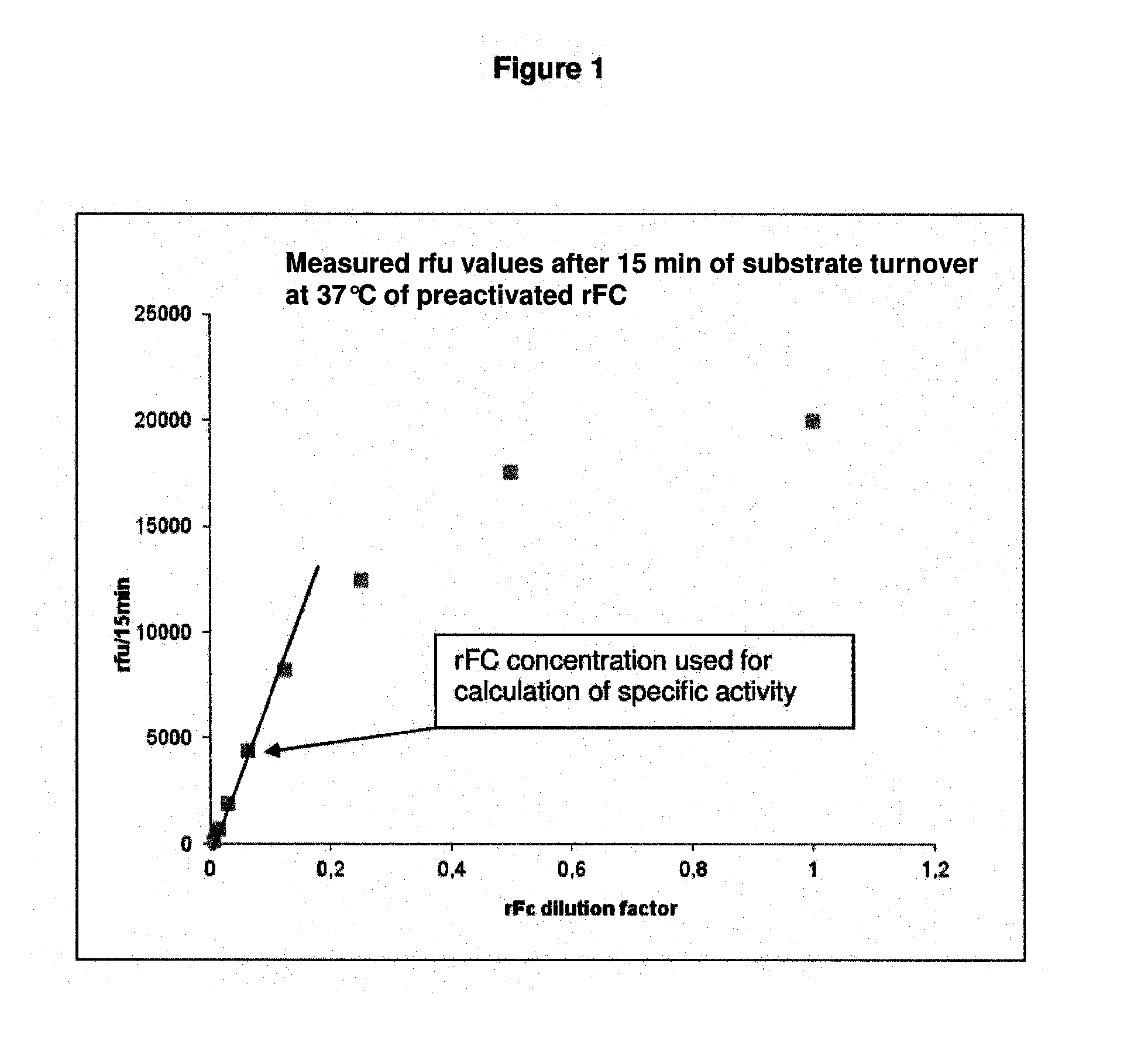Method for recombinant production of horseshoe crab factor c protein in protozoa
a technology of horseshoe crab and factor c, which is applied in the field of recombinant production of horseshoe crab factor c protein in protozoa, can solve the problems of cleavage, inability to obtain recombinant factor c as secreted protein, and inability to provide glycosylation
- Summary
- Abstract
- Description
- Claims
- Application Information
AI Technical Summary
Benefits of technology
Problems solved by technology
Method used
Image
Examples
example 1
Cloning of Factor C Gene into Expression Vector and Transformation of E. coli DH5α
[0208]Starting point for cloning of Factor C gene into an expression vector was the Factor C sequence from Tachypleus tridentatus (NCBI Accession Number P28175.1; therein reference 1: Muta et al. 1991, J. Biol. Chem. 266(10):6554-6561). The amino acid sequence of the wild type Factor C protein from T. tridentatus as shown under Accession Number P28175.1 has a length of 1,019 amino acid residues. The leader sequence, which is cleaved off after expression and secretion of the protein, has a length of 25 amino acid residues (residues 1-25 of the amino acid sequence shown under Accession Number P28175.1). The amino acid sequence of the wild type Factor C protein from T. tridentatus without the leader sequence is shown in SEQ ID NO: 2. The nucleotide sequence encoding wild type Factor C protein from T. tridentatus as shown in SEQ ID NO: 2 is given in SEQ ID NO: 1.
[0209]The T. tridentatus sequence of SEQ ID ...
example 2
Transfection of Leishmania and Selection of Clones
[0211]Preparation of Expression Vectors for Transfection
[0212]A Leishmania host cell-specific expression vector was prepared, which comprises the codon-optimized sequence of SEQ ID NO: 3 and a signal peptide sequence for secretory expression of the target protein in Leishmania host cells. The amino acid sequence of the secretory signal peptide sequence from Leishmania tarentolae is shown in SEQ ID NO: 5. The Leishmania leader sequence is cleaved off after expression and secretion of the protein.
[0213]Transfection of Leishmania Cells
[0214]The stable DNA transfection of a wide range of trypanosomatids, including transfection of Leishmania by electroporation, has been described in the art (Beverly and Clayton 1993, Methods Mol. Biol. 21:333-348; Coburn et al. 1991, Mol. Biochem. Parasitol. 46: 169-179). Here, culturing and transfection of Leishmania cells was performed applying a High Voltage protocol for transfection (Jena Bioscience G...
example 3
Expression and Purification of Recombinant Factor C Protein
[0218]The recombinant protein expression in trypanosomatid protozoa, in particular in Leishmania, is described in the art (Breitling et al. 2002, Protein Expression and Purification 25:209-218; Basile and Peticca 2009, Mol. Biotechnol. 43:273-278). Here, culturing and engineering of Leishmania for expression and purification of Factor C protein was performed using a gene expression kit provided by Jena Bioscience GmbH, Jena, Germany.
[0219]3.1 Maintenance of Production Strains
[0220]Production strains were cultivated in 10 ml volume in culture flasks at 26° C. in the dark. Strains are serially diluted 1:20 or 1:50 every 2-3 days into fresh culture medium containing all additives and antibiotics for the selection of inserted genes.
[0221]After 3 month, cultured strains are discarded and a new culture was started from a fresh glycerol stock.
[0222]3.2 Expression
[0223]A pre-culture was set up by diluting the production strain 1:50...
PUM
| Property | Measurement | Unit |
|---|---|---|
| molecular weight | aaaaa | aaaaa |
| molecular weight | aaaaa | aaaaa |
| molecular weight | aaaaa | aaaaa |
Abstract
Description
Claims
Application Information
 Login to View More
Login to View More - R&D
- Intellectual Property
- Life Sciences
- Materials
- Tech Scout
- Unparalleled Data Quality
- Higher Quality Content
- 60% Fewer Hallucinations
Browse by: Latest US Patents, China's latest patents, Technical Efficacy Thesaurus, Application Domain, Technology Topic, Popular Technical Reports.
© 2025 PatSnap. All rights reserved.Legal|Privacy policy|Modern Slavery Act Transparency Statement|Sitemap|About US| Contact US: help@patsnap.com

